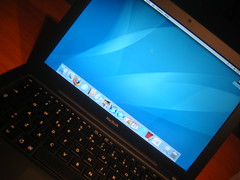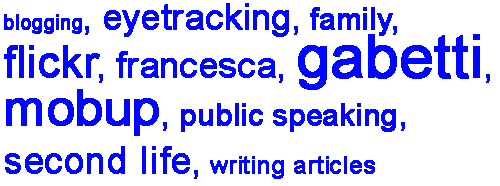A couple of months ago I’ve been interviewed by Dario Melpignano, managing Director at Neos Research, for the aim of the SPICE project, with the aim to address the still unsolved problem of designing, developing and putting into operation efficient and innovative mobile Service creation/execution platforms for networks beyond 3G.
here below you’ll find the translated (the phone call wa in Italian) transcript of what I said. Hope you’ll find it useful.
To provide a broader background I think it’s useful to know that I work in Gabetti, the most important real estate operator in Italy which is transforming itself into a full service company, operating also as a new media company thanks to the relevant base of shops widespread all over the country. On each of these sales point or shop, Gabetti has installed interactive touch screens proposing their offer and a number of additional services to the general public. An approach that the company is willing to extend to individuals through mobile local/proximity services.
Considering your industry and market, which services you see as the most successful in a 5-10 years timeframe?
We see emerging services mostly related to location identification and location based service. E.g. I am physically in a specified location and based on my profile I can find in a specific area the commercial proposals that fit my needs and interests. Given my preferences and economic constraints.
Additional examples can be to link photos to location, as in the case where I take a picture and find available houses that match my profile, etc.
How do you see the value network structured, which are the players and their role in the perspective of the organization where you are working: telecom operator, device manufacturer, application/service/solution developer/provider, consumer electronics player, publisher, internet/IT leader (such as Google or MSN)?
My value network is consistent with your view. There’s also a role for a management consulting firm, that in bigger companies like mine usually have a role.
Are the players envisioned by SPICE a correct representation of this future or would you take into account different or new roles?
Yes. I think I basically already answered you.
Which are the most critical requisites that you would consider for a technology platform such as the one that will be implemented in SPICE, designed to provide a unified way to deliver services over heterogeneous execution platforms, network and mobile devices?
- Requirements for billing and charging
- Requirements for revenue sharing including advertising revenues
- Requirements for non-core business, and semi-professional content providers producing and publishing their content on the platform
- Requirements for interactivity features
- Other requirements?
Billing is one of the most critical requirements to be supported in SPICE and the space where I see a relevant opportunity for innovation. Considering especially the link between network, content and service provider.
Interaction requirements are not really critical, as on a mobile device you have such a big constraint in terms of user interface that most evolutions failed so far. So I expect that the user interaction would be as low as possible.
What is the role of personalization in the end users™ perspective? Which are the most critical requirements?
It is crucial. In essence: give to the user the kind of services he needs, now, without him having to ask.
Mobile devices are mainly used as mediators in social relationships, a set of specific SPICE enablers will allow users to support social networks and improve their ability to function in their social context and therefore enhance people social effectiveness. Which requirements do you see here linked, if any, to your industry needs?
We are now interrogating about how to link social networking into our house search and acquisition business. Difficult topic, being the house maybe the most personal product one might need. So it is very difficult to infer recommendations for others. So far the function used to propose a house to a friend was only used as a personal reminder for a potential buyer. So far therefore I see a very limited impact.
What are the most critical issues and most relevant requisites to enable rapid service creation and composition for the end users within your specific content/media perspective?
For rapid service creation, what is needed is the possibility to personalize service creation at the API level. Provide application primitives and functions to be combined. And providing APIs is even more relevant than providing open code, as it shortens my time to market.
How would you adopt and use, if any, tools for intellectual property protection, such as DRM (Digital Rights Management)? Which benefits and hurdles do you see in adopting DRM?
I am against DRM, I see Creative Commons as a much more interesting approach. This approach if pushed will eventually end up in a more ethical society. Also technically speaking this approach is more consistent with the possibility of transforming content in a controlled way.
How do you see the evolution of the content/industry with reference to the mobile industry? More specifically do you envision a converging future (fixed, mobile, triple play, etc.) or a diverging one? Why?
I see both a converging and diverging future. It is converging at the device level in my personal experience. I do not believe at all in mobile TV, but for very short video clips and more in general in the possibility of using video in a mobile device, because of the high level of attention required. I spoke with a number of 3 people (video mobile operator in Italy) who are convinced about this being a big opportunity, but I don™t believe in it.
Would you see meaningful complementing content with context information, such as georeferencing and tagging by allowing open categorization approaches (folksonomy)?
Context value around a piece of content will be of bigger value than the content itself
- a digital photo has a value
- a digital photo uploaded online acquires a much more significant value
- a digital photo online and positioned on a map acquires an even greater value
Paraphrasing Metcalfe, I would say for joke, but not so much of a joke, that the value of a piece of content equals the square of the point of its context.
How much should the end user be active and participate to the media fruition process?
The user should be active, and be able to select, but only if he wants to. Let the user choose whether to be active or not.
Which is the role, if any, of long tail (e.g. personal media, such as blogs) content production and distribution models, of open delivery models within your industry? Who do you expect to pay whom and for what?
In my industry the content producer is the client, and my role is basically as a “publisher” to mediate among users. If de-intermediates happens, I disappear.
What are your ideas about content adaptation? Would consider appropriate that a third party dynamically adapt your content (e.g., to match the capabilities of a network or a mobile device)? Or would you prefer a system to automatically control the adaptation process and when would you prefer the end-user to manually control that process?
Ideally content must be able to follow me not only in space, but also in its form and format. I expect to be able to play the same piece of audio or audiovisual on any device of what you depicted as distributed communication sphere.
What are your ideas about users using different devices to receive different parts of the same multimedia transmission (e.g., a cell phone to receive the audio part and a wall-mounted display to receive the video part)? What are your ideas about receivers dynamically switching between these devices (e.g., by dynamically transferring a video stream from a cell phone to a near-by TV screen)?
I see that this approach is relevant and will be in the future. Like in Firefox Web browser I can centralize and access my bookmarks on any computer I use. The same should happen to content. In the future I expect to be able to grab a video stream from a tv with my device and bring it with myself while moving to another place to resume playing.


